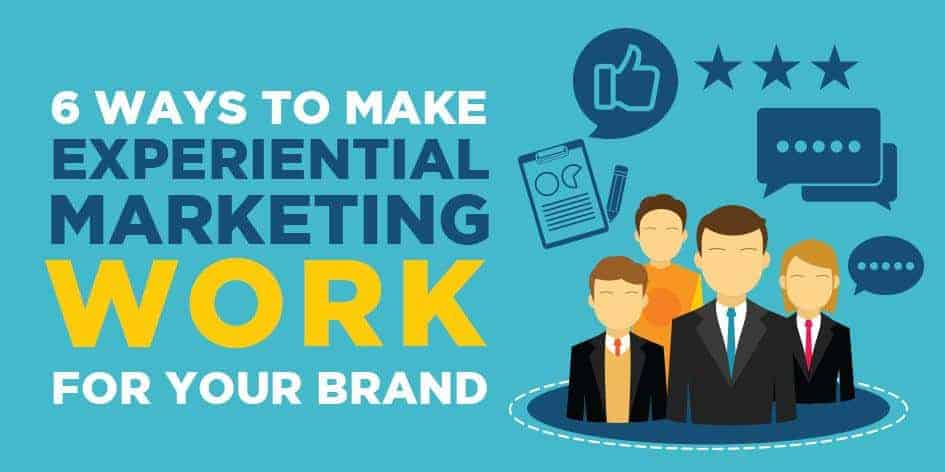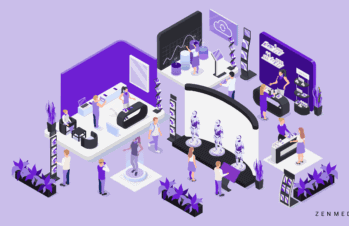Any teacher can tell you that kids learn better when they get to participate in their learning.
Whether it’s as simple as pouring vinegar onto baking soda to watch a chemical reaction, or as complicated as creating a business plan for a hypothetical business, experiencing something is almost always more effective at helping us retain information than just seeing or hearing that information alone.
And guess what? Teachers aren’t the only ones in on this secret. Savvy marketers have been applying this truth to their marketing efforts for years. It’s called experiential marketing, and used correctly, it can be a powerful way to amplify your brand message.
If you’re new to experiential marketing, here’s an overview – along with ways you can make it work for your brand.
In experiential marketing, experience > marketing.
Experiential marketing is a marketing tactic that directly engages consumers, inviting them to participate in a brand’s ongoing story.
Some examples of experiential marketing, for example, include:
Heineken’s “Departure Roulette,” which gave airport travelers the chance to “drop everything” and commit to a trip to an unscheduled location.
The Aston Martin On Ice campaign, which invited journalists and industry insiders to test-drive the new Aston Martin on icy, snowy roads in Colorado.
Google’s Building a Better Bay Area, which installed interactive posters in public places that allowed people to vote for which philanthropic causes Google should fund.
Now, you may notice that these are all pretty major campaigns from massive brands, entailing a whole lot of resources both financial and otherwise. You may be thinking, “My business could never pull off something like that.”
The good news is that it doesn’t have to. Experiential marketing can work just as well for small and medium-sized businesses as it does for large ones – possibly even better, as smaller businesses often have stronger ties with their customers simply out of necessity.
Just like experiential marketing doesn’t have to be on a grand scale in order to work, it also doesn’t have to be expensive. Here are a few real-life ideas that can be executed on a shoestring:
- Pop-up shop giving out samples of a new product
- Flash mobs
- Interactive, public art installations
- Food truck rodeo
Now that you’ve got a good feel for what experiential marketing is, here are a few pointers for how to make it work for your brand.
Don’t interrupt your audience.
This is key for any inbound marketing strategy, actually. When you’re planning an experiential marketing campaign, you’ve got to reach your customers where they are.
Let’s take that pop-up example from above. If you’re a coffeemaker company that’s debuting a new coffeemaker by giving away free coffee, as DeLonghi Australia did in 2016, you’ve got to do it in a place that makes sense – a place where your customers already are.
That’s why DeLonghi chose a heavily trafficked area in Sydney during morning rush hour to launch its Baristaless Cafe. This was an unstaffed cafe where commuters could create “barista-quality” drinks with the touch of a button on the company’s new PrimaDonna Elite machine.
DeLonghi was able to hit a perfect target audience with this placement: people who work and who drink coffee in the mornings. Another perk of this placement, though, is that they were able to attract people who might be on their way to get a latte from a coffee shop. If they passed a chance to get free coffee on the way there, chances are that coffee shop just lost a customer to DeLonghi.
Make sure your message is clear and on-brand.
There are all kinds of cool events and experiences you can create for your customers, but they’re only going to work if they:
- Offer a clear message to your consumer
- Make sense with your brand
For example, the Aston Martin on Ice campaign was totally on brand and had clear messaging.
The message was that the Aston Martin can handle much rougher conditions than you thought it could. The activity – working with an instructor to learn to drive the car on ice, in a beautiful location – was on-brand in that it was a luxury experience designed to make you feel – well, kind of like James Bond.
For an aspirational brand like Aston Martin, that’s pretty on point.
Set concrete goals and decide how you’ll measure success.
Experiential marketing can be difficult to measure, but that doesn’t mean you shouldn’t try. In fact, the opposite is true.
While you may have no trouble selling your initial experiential marketing campaign to the rest of the C-suite, if all you have to show for it are pictures of how many people were there and a couple half-baked statistics, you’ll likely face resistance the second time around.
There are several ways you can measure your campaign success. How you do it depends on your goals. If you’re trying to increase brand awareness, you could measure the increase in social media mentions for the days following the campaign.
If you’re trying to sign up new customers, measure the increase in sign-ups through your website. Whatever you’re measuring, make sure to track it over several days or a week so you capture any afterglow effects. That will allow you to determine a more accurate ROI.
Try out new partnerships with other brands.
One of the great things about experiential marketing campaigns is that they often offer excellent opportunities to partner with other brands. This can allow you – and your partner brand – to reach new, previously untapped audiences.
If you’re looking to partner with another brand, the cardinal rule is mutual benefit. You’ve both got to stand to benefit from this event.
One example is from Netflix’s Gilmore Girls revival in 2016. The company turned neighborhood coffee shops around the country into Luke’s Diner, the iconic diner in the show, and handed out free coffee to passersby for a day.
The benefits for both brands are evident: the coffee shops reach potential customers who love Gilmore Girls, and Netflix builds momentum for the release of its new series.
When you’re putting together your campaign, think about potential brand partners – and don’t be afraid to get creative. After all, Google and Zappos had a fun little giveaway stand-off in Austin that may or may not have been planned, but was definitely beneficial for each. If those two mega-brands can do it – and in such an unconventional way – you can, too.
Include both offline and online elements in your campaign.
Since experiential marketing, almost by definition, takes place offline, it’s a good idea to include some way for participants to share their experiences online. Have a sign with a hashtag and ask people to post pictures, or hand out free ice cream to people who receive a digital coupon by downloading your app on the spot.
There are a whole lot of ways you can bring the offline world online – and vice versa.
Keep it short and sweet.
No matter how amazing your experiential marketing campaign is, you’ve got to keep it short and sweet. In general, people want to give you a couple of minutes, at the most – enjoying a free sample, voting for a charity with a quick click, or browsing a pop-up shop take about the right amount of time.
If you’re asking people to stay with you longer than that, you’d better have something amazing for them – you know, like Bud Light’s Real Pac Man game from their 2015 Super Bowl campaign.
Experiential marketing can be a highly effective way to gain attention for your brand and earn more loyal customers, even converting some into brand advocates. If you’re interested in learning more about interactive marketing, read our post “How We Earned Dippin’ Dots More Coverage Than a Super Bowl Ad … Without Spending a Dime on Paid Advertising.”







